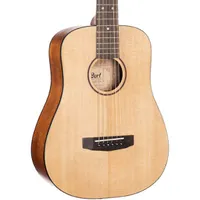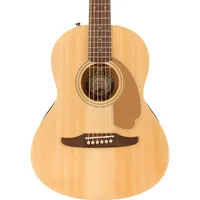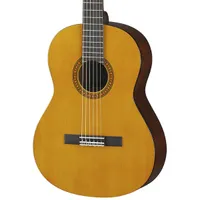Best 3/4 acoustic guitars 2025: Portable playability from Taylor, Martin, Yamaha, and more
Perfect for beginners and seasoned professionals alike, 3/4 size acoustics make great guitars for all kinds of players

I've always been a big fan of smaller-body acoustic guitars, and to be honest I'm not sure why more players don't start with one of the best 3/4 acoustic guitars. My first attempt to learn the guitar was on a dreadnought-size acoustic that was way too big for me, and it wasn't until I got my hands on the smaller-scale classical guitar I found it comfortable enough to continue playing.
That doesn't mean that 3/4-size acoustics are just for beginners, though. Twenty years later I'm still using 3/4 acoustics in my day-to-day, and I have one as a designated sofa guitar that I pick up to noodle or write licks on. I've used it to record and it delivers on the sound front while being easily transportable and comfortable to play.
I've played a lot of acoustics over the years, as well as testing them and reviewing them in my daily work as a MusicRadar gear expert. From using them in recording studios to accompanying singers in a live scenario, I'm no stranger to a good 3/4 acoustic guitar, which is why I've put this guide together to help others learn from my experience.
For me, the best 3/4 acoustic guitar overall is the Taylor GS Mini. It's been out for around 15 years now, and offers the perfect combo of playability, portability, quality tonewoods, and build quality. It's not cheap though, so if you want a 3/4 size acoustic that's a little less stressful on the wallet, have a look at the Yamaha JR1 FG 3/4. It's well below the $200 mark and as is usual with Yamaha acoustics, punches well above its weight in terms of sound, playability, and build quality.
If you're reading this looking for your first 3/4 acoustic or even your first guitar outright, I've put together a handy how-to-choose section that gives you the low down on everything you need to know before buying. I've also got a general FAQs section for any questions you might have, and a glossary of key terms to help you decode the guitar-specific lingo you might encounter in this guide.
My top picks

The Taylor GS Mini is my favorite 3/4 acoustic guitar, but it's also one of the best acoustic guitars ever made. Packing superb sound quality and playability into a superbly well-built and compact package, it delivers on all fronts, making it a great pick for anyone after a top-quality small-body acoustic.

If you're looking for a budget 3/4 acoustic guitar, I highly recommend checking out the Yamaha JR1 FG 3/4. It delivers a lot of relatively little money, and is a great option for younger players or first-timers, as it's available in a kit that gives you all the accessories you need to get up and running.
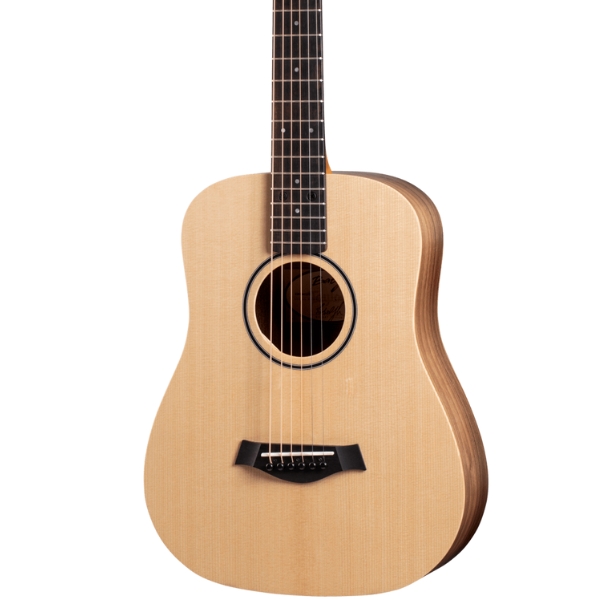
It might look like a toy, but the Taylor BT1 'Baby Taylor' very much took me by surprise when I first played one. It absolutely delivers in terms of sound quality, and the small size means it will easily be handled by beginner players. If you're looking for a first acoustic, this is an awesome choice.
Best overall

Specifications
Reasons to buy
Reasons to avoid
The Taylor GS Mini-e Mahogany is really a thing of beauty, stuffing full-size Taylor tone into a conveniently sized package. It’s a great option for the beginner player looking to make their first strides with the instrument, with enough quality to satisfy even professional guitarists.
The smaller scale makes it effortlessly playable, but it keeps the string spacing of its full-sized brethren so it won’t feel too alien to those who’ve played a Taylor before. The Ebony fretboard is smooth and features a wood grain unique to the guitar.
Thanks to the Mahogany top it’s got a very warm tone overall, with a depth that belies its smaller stature. The onboard electronics offer treble and bass controls that allow you to sculpt its natural character when you plug in for your next gig.

"This is a guitar with its own vibe and voice - and both are very appealing. Of course, the guitar is compact and built to a price, but Taylor's vast experience in production guitar manufacturing ensures that these 'economies' don't get in the way of the important things: playability and sound."
Read more: Taylor GS Mini-e Mahogany review
Best budget
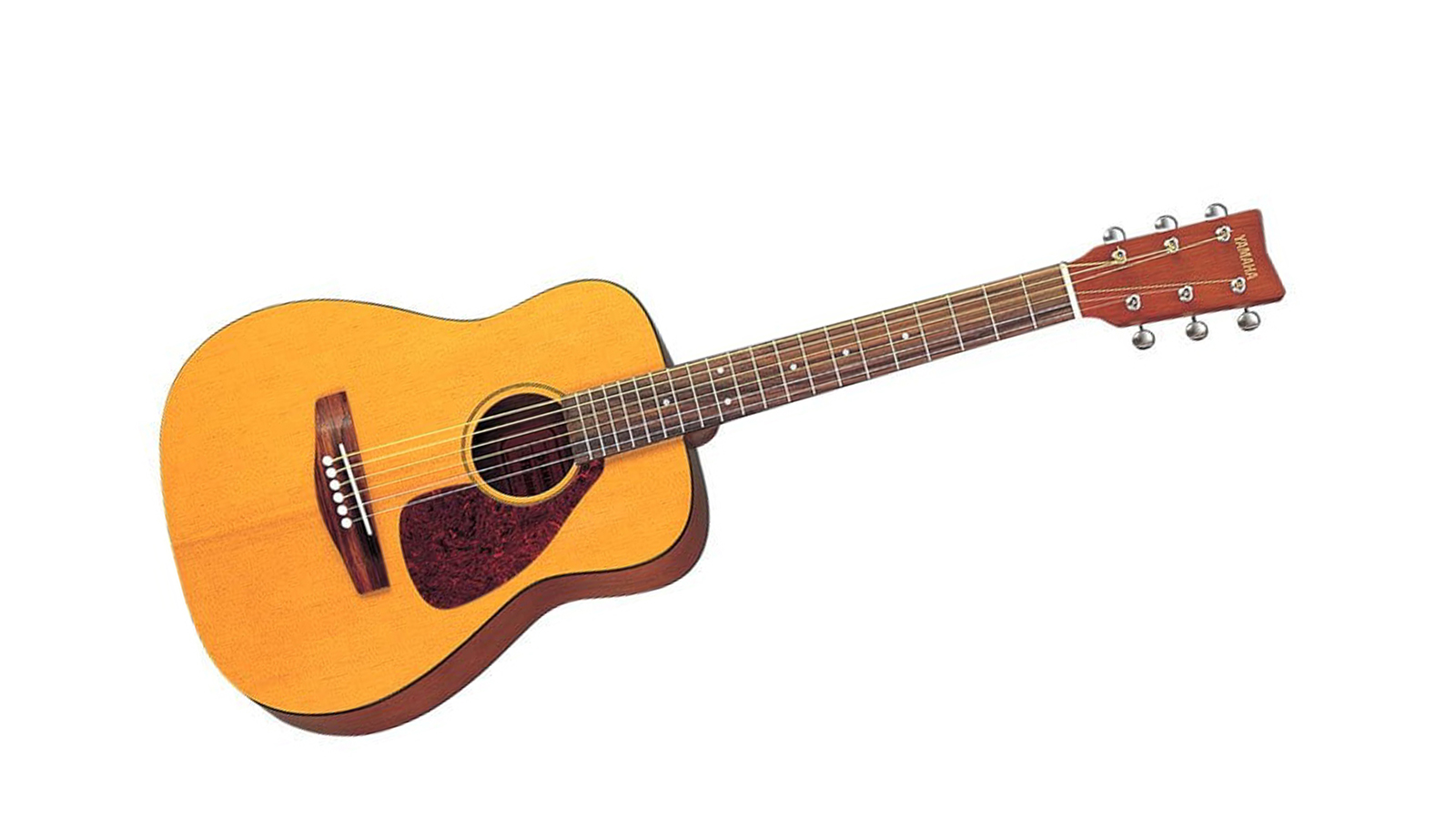
2. Yamaha JR1 FG 3/4
Our expert review:
Specifications
Reasons to buy
Reasons to avoid
For beginners or those on a budget, you can’t do much better than the Yamaha JR1 FG. It delivers outstanding tone and playability for the money, coming bundled with all the accessories you’ll need to get your guitar journey started.
The slim neck makes this guitar incredibly playable, combining well with the short scale to provide the perfect platform for beginner and younger players. A rosewood fretboard offers a smooth playing feel for your fretting hand.
In terms of tone, like most 3/4 acoustic guitars it suffers a little in the low end. That said it’s got plenty of brightness in the mid and upper ranges, and a projection that’s more than suitable for the vast majority of playing scenarios a beginner will encounter.
Best for beginners
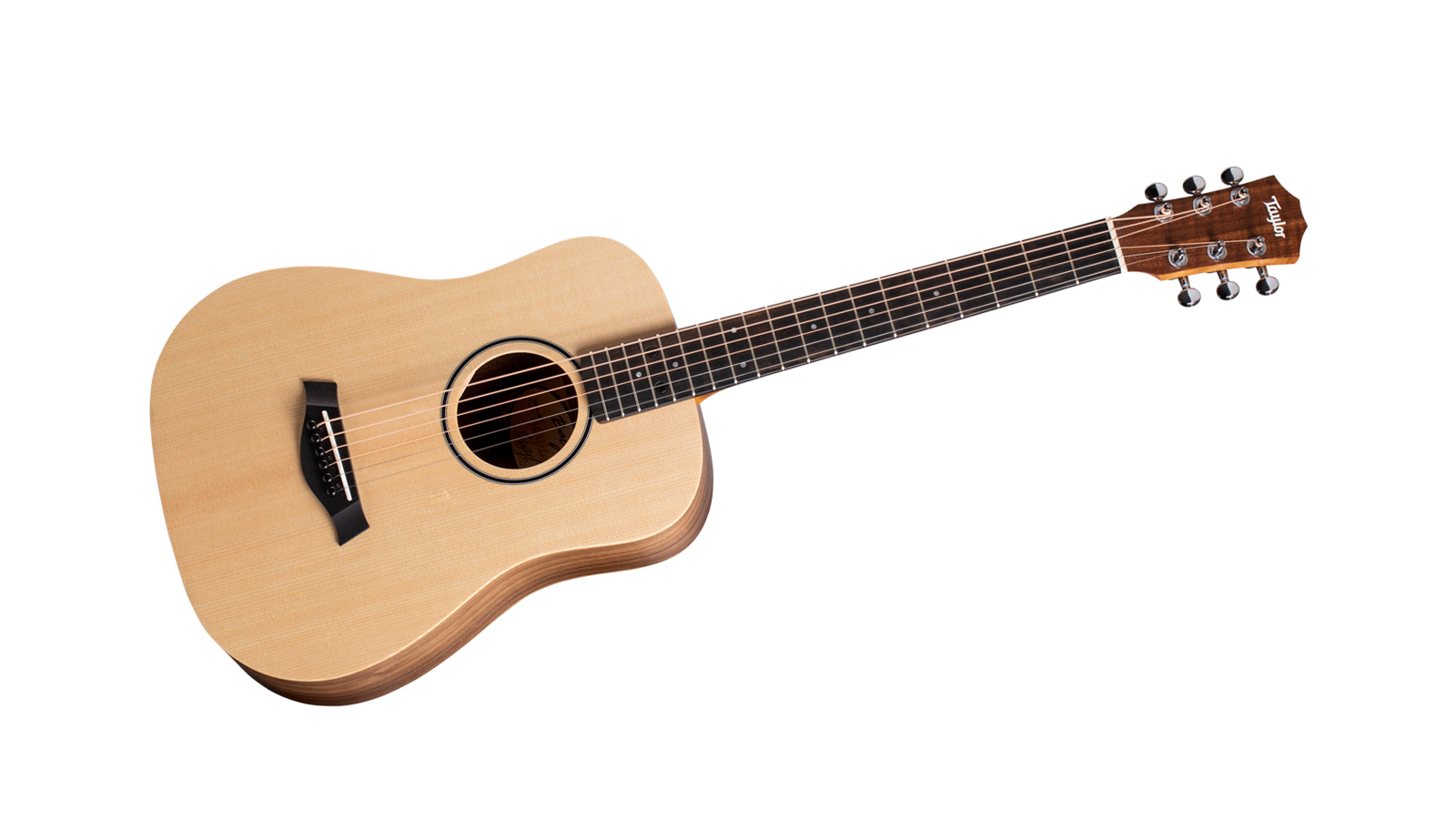
3. Taylor BT1 ‘Baby Taylor’
Our expert review:
Specifications
Reasons to buy
Reasons to avoid
Despite its moniker, the Taylor BT1 ‘Baby Taylor’ is a very grown-up guitar. It delivers a tone and playability that will suit professionals and apprentices equally well, in a high-quality package from one of the behemoths of acoustic guitar building.
A small neck heel allows great access to the upper frets and it comes with a low action out of the box, making it easy to fret for beginner guitar players. It’s got great dynamic range too, reacting equally well to the soft touch of fingerstyle as it does hard-strummed chords.
Despite its small size, it doesn’t suffer from any boxiness in tone, delivering a full and rich sound. The lows are tight, mids clear and highs crisp, and the resultant projection is really quite good for a guitar of this size.
Best for adults
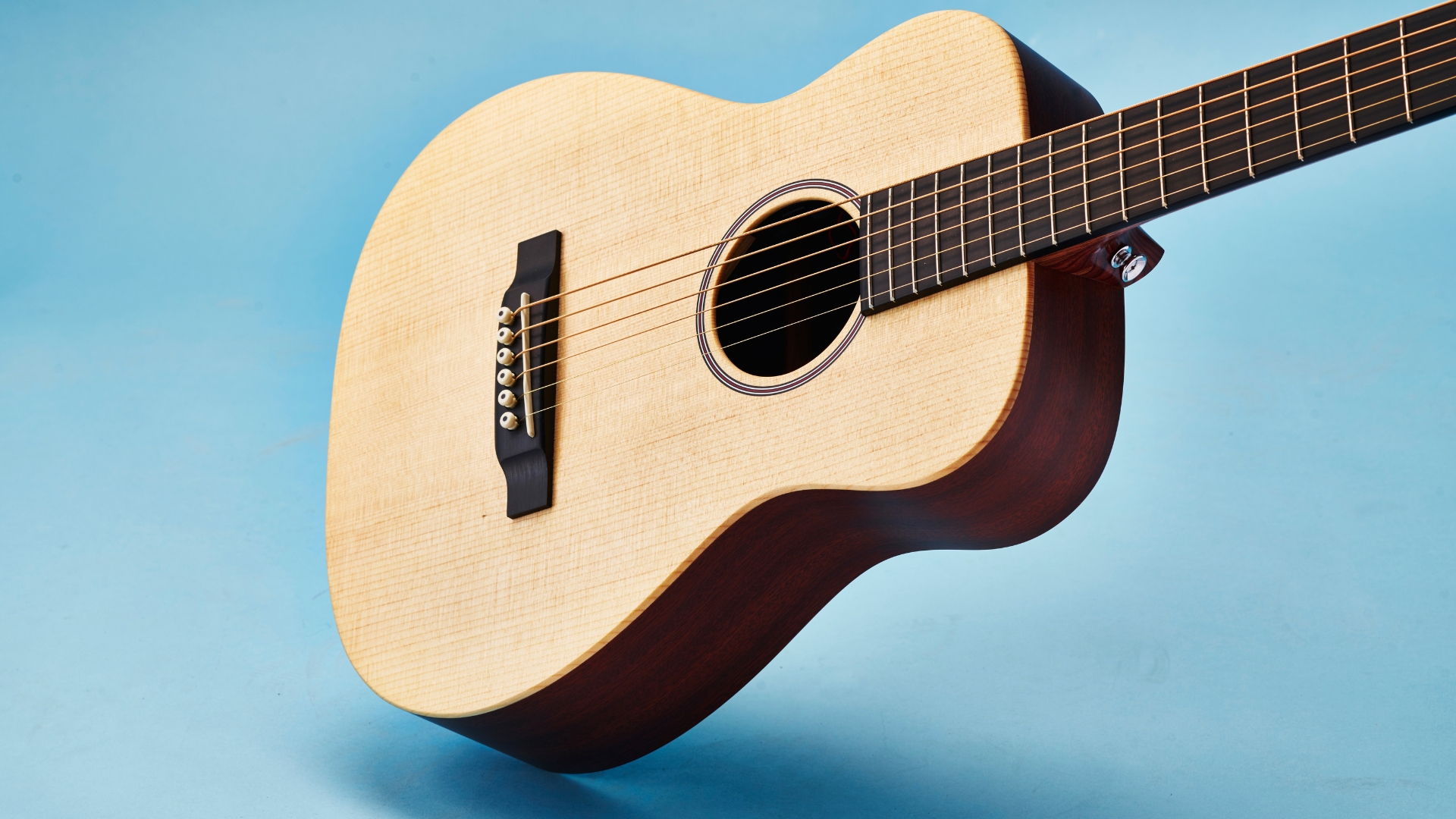
Specifications
Reasons to buy
Reasons to avoid
The Martin LX1E ‘Little Martin’ gives you a huge sound in a small package. It’s louder than a lot of other 3/4 acoustic guitars thanks to its X-bracing and solid top, delivering a quality that will meet the needs of beginners and pro players alike.
If you’re coming from a full-size acoustic, you’ll find the neck width roughly the same as a regular Martin. Combined with the short scale, it gives the guitar excellent playability all across the FSC Certified Richlite fretboard.
Unplugged it offers an articulate and defined sound that is surprisingly loud for its size. The Fishman Sonitone onboard electronics are fantastic as well, really allowing the guitar's natural tone to shine through.

"The Little Martin does feel a little industrial, but from the first strum its more conventional spruce-top voice has us captivated. If you're a classic Martin fan, this is just miniaturised with a lovely crisp-edged voice."
Read more: Martin LX1E 'Little Martin' review
Best for live performance
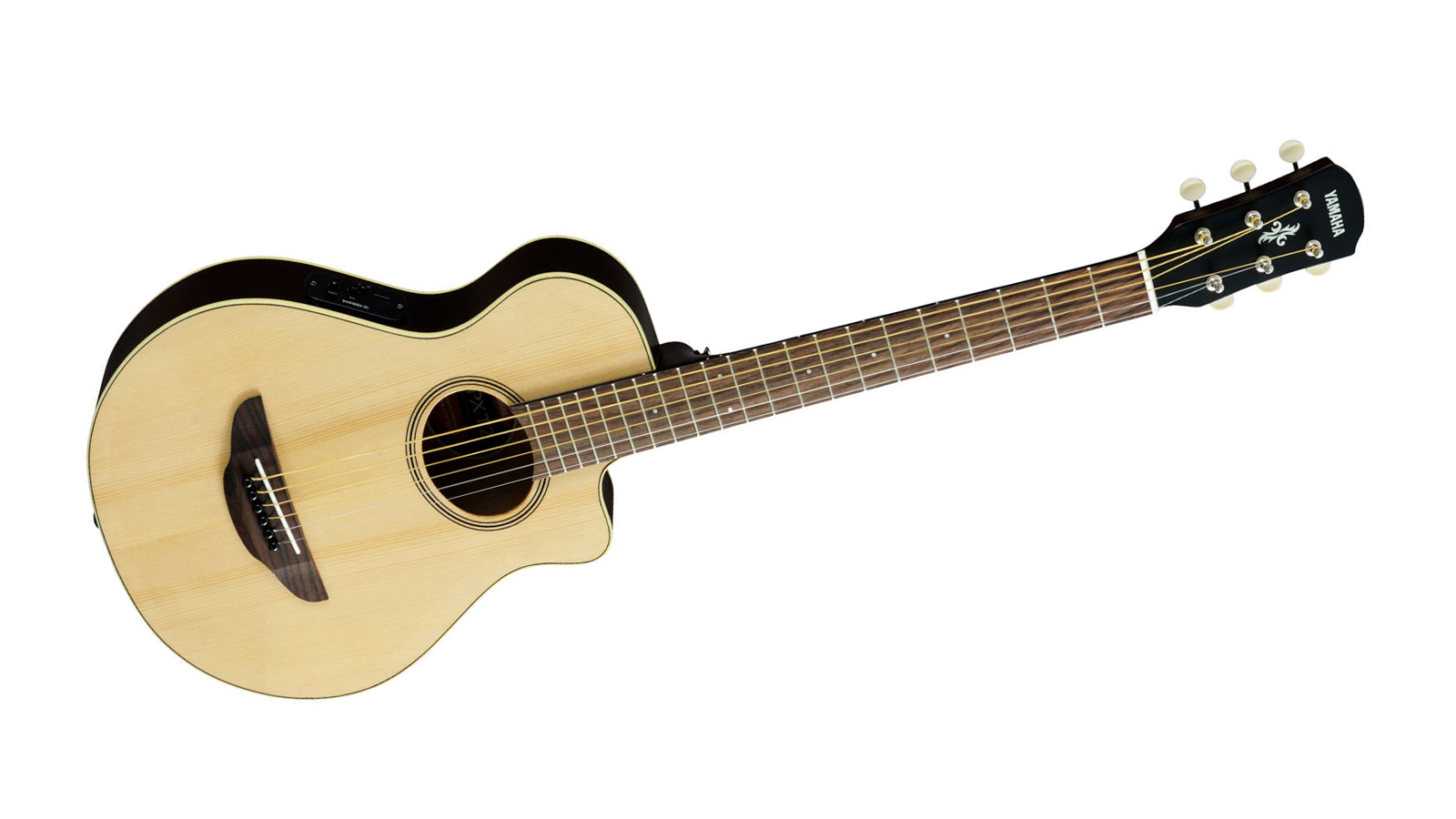
5. Yamaha APXT2 3/4 Acoustic Guitar
Our expert review:
Specifications
Reasons to buy
Reasons to avoid
The Yamaha APXT2 is marketed as a travel guitar, but it’s so much more than that. Featuring a super fast playing neck that will suit those used to electric guitars, as well as excellent onboard electronics, it’s a great guitar for gigging too.
Thanks to its cutaway design you’ve got easy access to the upper frets, and the slim neck profile is a joy to play on. The fretboard is a similar width to a full-size guitar, so will feel familiar to players who already have some experience under their belt.
Despite the thin body depth, it’s got more than enough resonance to fill the room when you play it unplugged. When you plug it in, the onboard pickup delivers a warm and pristine acoustic guitar tone, perfect for live performances.
Best classical

6. Cordoba Cadete 3/4
Our expert review:
Specifications
Reasons to buy
Reasons to avoid
The Cordoba Cadete 3/4 Classical is a brilliant option for those looking to take the classical guitar route. Its soft nylon strings make it much easier for beginners to play for longer, but this guitar has a feature set that makes it great for more seasoned players too.
A comfortable, Mahogany neck delivers a stable playing platform that’s perfect for fingerstyle. The flat-radius Rosewood fretboard encourages classical-style playing, but you’ll still find plenty of other styles working well here.
A solid Cedar top is a surprise at this price point, delivering some serious sonics which makes it comparable to full-size classical acoustic guitars. It resonates beautifully, offering up a delightful tonality no matter your playing style.
Spec comparison
If you're struggling to decide between any of my top picks, this spec comparison table gives you a nice overview of all the key features of each, which should assist you in deciding which is best for your particular needs.
Model | Top | Back & sides | Neck | Scale | Fretboard | Frets | Electronics |
|---|---|---|---|---|---|---|---|
Taylor GS Mini | Tropical Mahogany | Sapele Laminate | Sapele | 23½" (622mm) | Ebony | 20 | Yes |
Yamaha JR1 FG 3/4 | Spruce | Meranti | Nato | 21.25” (540mm) | Rosewood | 20 | No |
Taylor BT1 | Sitka spruce | Layered Walnut | Tropical Mahogany | 22¾" (558mm) | Ebony | 19 | No |
Martin LX1E | Solid Sitka Spruce | High Pressure Laminate | Rust Birch Laminate | 23” (584mm) | FSC Certified Richlite | 20 | Yes |
Yamaha APXT2 | Spruce | Meranti | Nato/Mahogany | 22.8" (580mm) | Rosewood | 21 | Yes |
Cordoba Cadete 3/4 | Solid Western Red Cedar | Mahogany | Mahogany | 24.2" (615mm) | Rosewood | 19 | No |
Also consider
For me, the guitars above are the ones you should be going for. That said, I appreciate there's no one size fits all guitar so here's some more great options for your consideration.
Gretsch G9520E ‘Gin Rickey’
Basswood top & body | Nato neck | Walnut fingerboard | 24" scale
The Gretsch G9520E Gin Rickey has been quietly developing a bit of a cult following with guitarists old and new. Standing out from the crowd thanks to its distinctive look, it also packs a serious punch with its unique Gretsch Deltoluxe soundhole pickup. Notwithstanding the great electronics, this guitar’s unplugged tone is incredible considering the price point. It offers a great low-end response for the size, taking open chords particularly well with an even note definition across the Walnut fretboard.
★★★★☆
Cort Earth Mini OP
Solid Sitka spruce top | Mahogany body | Mahogany neck | Merbau fingerboard | 22.8" scale
The Cort Earth Mini OP has a surprising spec considering its price, with features you’d normally find on models two or three times the price. For a beginner guitar player, you’ll be hard-pushed to find such a high-quality guitar elsewhere. It features an unusual soft ‘V’ shaped neck, which helps new players fret chords with ease. The neck profile provides a great platform for speedy licks from those who are more experienced and, despite the extra small scale length, it doesn’t feel cramped at all.
★★★★☆
Fender Sonoran Mini
Spruce top | Mahogany body | Nato neck | Walnut fingerboard | 24.1"
The Fender Sonoran Mini is a fantastic 3/4 acoustic that offers great value for money and time-tested Fender build quality. Despite being best known for its electric guitars, the Sonoran Mini proves Fender knows what it's doing when it comes to acoustics too. The Walnut fretboard feels wonderful under your fingers and the Sonoran Mini features the ever-popular Fender ‘C’ shape neck profile. It gives you the best of both worlds in terms of speed for acoustic guitar licks and heft for chord work.
★★★★☆
Yamaha CS40 II Classical 3/4
Spruce top | Locally sources tonewood body & neck | Rosewood fingerboard | 22-13/16" scale
The archetype for beginner classical guitars across the globe, Yamaha’s CS40 II is a staple in educational institutions worldwide. It offers excellent playability alongside surprisingly good sound, despite its small price tag. The flat-radius fretboard is really comfortable to play thanks to the shorter scale length. Its Rosewood construction is nice and smooth, combining with the nylon strings well to deliver easy playability.
★★★★☆
Key terms

Struggling to understand some of the lingo associated with 3/4 guitars? Well to help explain all this guitar-specific gobbledegook I've put together a handy glossary of key terms that will help you unlock your guitar lexicon.
- Action - a term to describe the height of the strings from the fingerboard.
- Acoustic-electric - an acoustic guitar that has a pickup built into it. Sometimes known as an electro-acoustic.
- Back and sides - the back and sides are components of the body. The back is the part that faces you when you sit down to play, and the sides are the thinnest part of the body.
- Bracing - a pattern of reinforcements inside of the guitar body, which affects the way the top of the guitar body resonates.
- Bridge - the part of the guitar that anchors the strings to the body, and also transfers some string vibrations to the guitar body.
- Fingerboard - where you place your fretting hand to play chords and licks.
- Frets - the metal strips on the fingerboard that divide it into notes.
- Intonation - how in tune the guitar sounds across the fingerboard. Signs of bad intonation are notes that sound in tune near the top of the fingerboard but go steadily out of tune as you move higher in pitch.
- Neck - the long wooden part that extends from the guitar body. The fingerboard is glued to the front of the neck.
- Nut - a small piece of plastic or bone near the headstock that holds the strings in place and sets the string spacing.
- Pickup - an electronic device that captures string vibrations in order to amplify them.
- Preamp - a control panel on an acoustic guitar that adjusts the volume and tone of the pickup.
- Saddle - a small strip of plastic or bone that sits on the bridge and supports the strings.
- Scale length - the distance between the nut and the bridge. A shorter scale length is why they call it a 3/4 size.
- Top (soundboard) - the top of the guitar is what resonates and contributes to the tone. The material of the top makes a big difference to how an acoustic guitar sounds.
- Tuners (machine heads) - sit on the headstock and enable you to tune the guitar strings.
How to choose

Whether you're getting your first guitar or just adding something different to an existing collection, there are a few key factors to look for when buying a 3/4 acoustic guitar. I've been playing over twenty years and spent 5 years in music retail helping guitarists find their perfect match, so let me guide you through what you should be looking for when you buy a new 3/4 size acoustic.
1. Solid vs laminate woods
MusicRadar's got your back
One of the defining factors of an acoustic guitar is the type of wood used in its construction. Solid woods sound better, but are more expensive whereas laminated woods don't sound quite as nice, but are a lot more affordable. If you're a beginner or buying for one, then it's probably preferable to stick with laminated woods to keep the costs down, this leaves you with more budget for accessories, lessons, and other essentials.
For those who already have some experience under their belt, spending more on a solid wood 3/4 size acoustic is a better choice, as you'll find a much more rewarding playing experience. Solid wood 3/4 acoustics can rival big body ones in terms of sound quality, with only volume being the differentiating factor.
2. Neck profile
Neck profile is the defining factor of an acoustic guitars playability, alongside the string action. A comfortable profile is essential for beginner guitarists, so when you're reading reviews or checking the guitar out for real, be sure to pay special attention to how the neck feels.
As 3/4 acoustics are generally quite small, you'll usually find that the neck profiles are quite slim which will make them inherently comfortable. That said, this could make them cramped for adults of those with larger dimensions, so something you'll need to take into account when making a purchase.
3. Action (string height)
Acoustic guitars can have a very unforgiving action out of the box, so if you're buying for a new player I would highly recommend taking it to a reputable tech or luthier to have them make the action comfortable. This will go a very long way to making the guitar more playable, and in turn, will keep the new player coming back for more.
If the action seems good enough out of the box, you can also make it easier to play by putting thinner gauge strings on. it's a good way to quickly improve the playability and in most cases, you won't need to tweak anything else to accommodate this change. There are some instances however when you might need to adjust the truss rod so if you're not comfortable doing this, you might be better off taking it to a professional.
Even if you're not new to the instrument, acoustic guitars can still feel quite unforgiving coming from an electric. It's not that simple to set them up yourself either, so if you're not certain it's definitely worth your while to take it to an expert.
FAQs
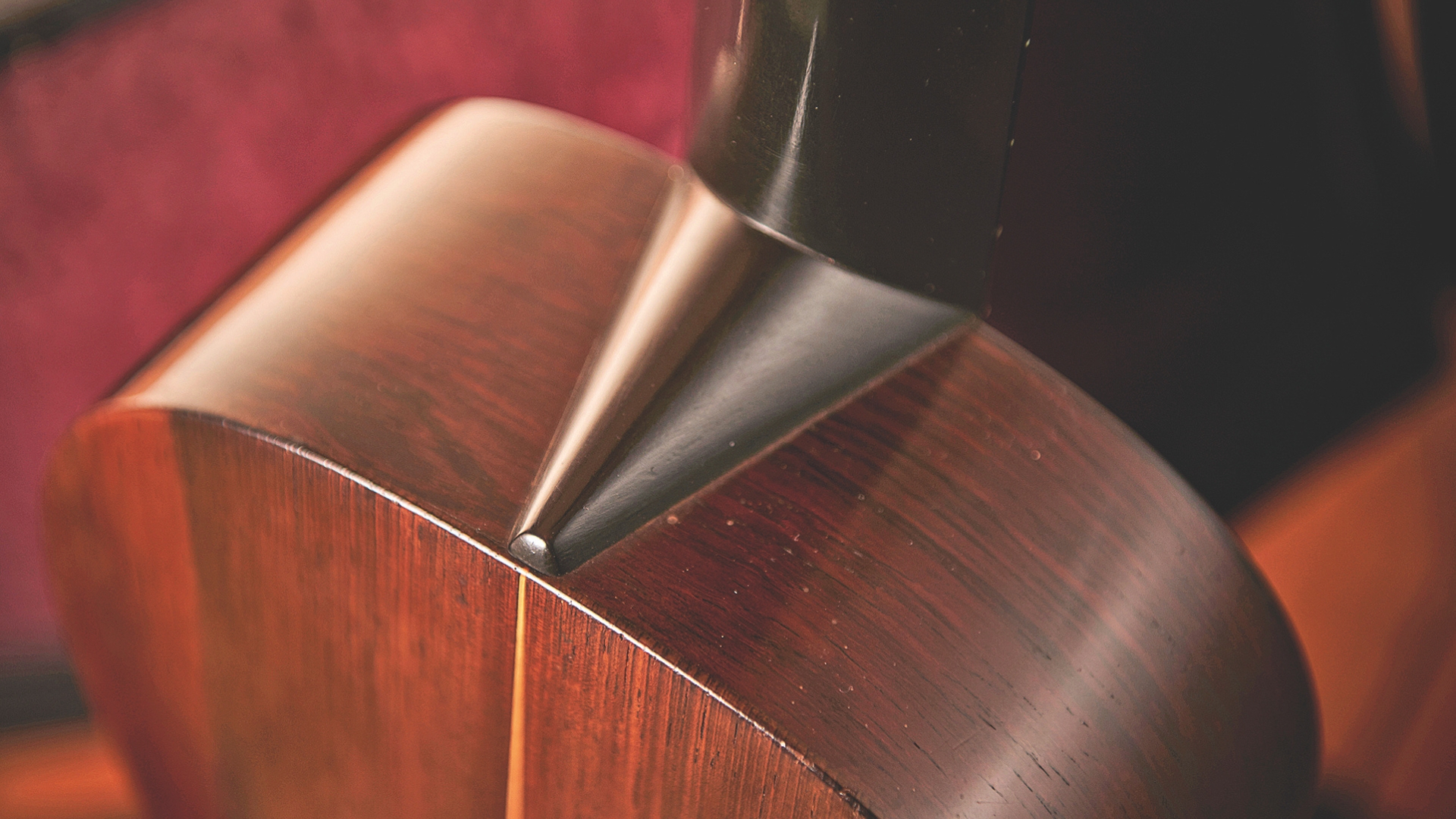
What is a 3/4 acoustic guitar?
When we talk about 3/4 acoustic guitars there’s something of a misnomer here. The term ‘3/4’ doesn’t actually refer to the physical size of the guitar, but something called scale length. Scale length is the distance between the nut of the guitar and the bridge. It affects the tension on the strings, the distance between the strings and the fretboard, as well as the distance between the frets. This last point is of particular importance: due to the shorter scale length of a 3/4 acoustic guitar, the space between the frets is smaller resulting in an easier playing experience for beginner guitarists or those with smaller hands.
What are 3/4 acoustic guitars typically made of?
Like their full-sized brethren, the best 3/4 acoustic guitars rely on a combination of wood types to generate their sound. The back and side wood will typically be composed of warmer-sounding wood types such as Mahogany, Sapele or Basswood.
The top wood is where the magic happens as this is the part that resonates in sympathy with the strings to create an acoustic guitar’s sound. For the majority of acoustic guitars, you will find Sitka Spruce (or one of its many variants) here, which delivers a bright, snappy sound that enhances the natural projection of the guitar.
It’s less common, but you can also find Mahogany top woods or, on occasion, more exotic choices like Koa or Cedar. What you choose is entirely down to personal preference, but there’s a reason that most guitars use a Spruce top wood as it offers the best tonal balance for a wide variety of playing styles.
Is a 3/4 guitar too small for adults?
This really depends on your hand size. For most adults, a 3/4 size guitar will feel a lot cosier, but you shouldn't have any issues playing one and in a lot of cases it's easier than playing a full-size guitar. That said, if you've got particularly large dimensions you may find the fingerboard feeling cramped, which could make it difficult to fret certain chords.
Can a child play a 3/4 size guitar?
Yes they can, and I would highly recommend a 3/4 guitar for any young beginners wanting to pick up the instrument. The smaller body size makes it easier to handle and carry to lessons, while the shorter scale allows for much more comfortable fretting of chords. A 3/4 guitar also has less string tension, which can make it easier to press down on the strings.
How we test
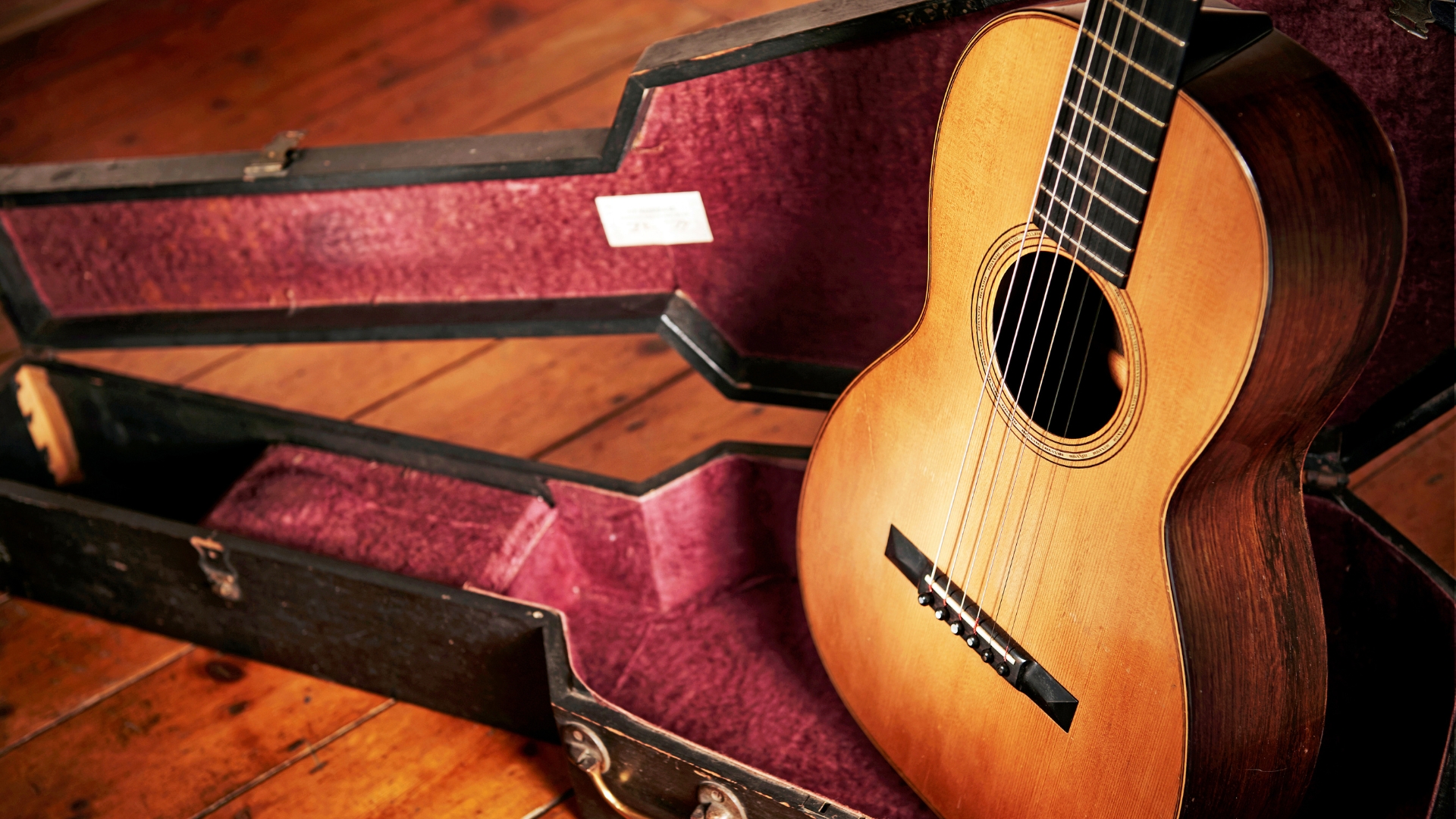
Here at MusicRadar our writing team has a huge amount of experience reviewing and testing gear, so you can rely on our recommendations when using our buyer's guides. Our writing team lives and breathes gear, whether that's playing in bands, doing session work, recording in studios, or just reviewing the latest bit of gear.
We always take care to test instruments and gear in a way that reflects how musicians will use them, and aim to spend at least a couple of weeks getting to know the ins and outs of it.
When conducting our tests on acoustic guitars we'll look at the following key aspects:
Build quality - here we're looking at how well put together the instrument is. Are there any blemishes in the finishing, are all the different components well held together? We'll look at the inside of the guitar to see how neatly the bracing has been applied, and check all across the fingerboard for any sharp fret edges or other playability issues.
Playability - next we'll play the instrument, trying various different techniques like flatpicking and fingerstyle as well as a variety of different genres. This allows us to determine what the guitar excels at in terms of play style, and to see how adaptable it can be.
Sound - finally we'll take into account the sound. This can be quite an objective thing, but our writers have a lot of experience with different acoustic guitars, so we'll be comparing them to the sound of other instruments we know well. We're looking to see the nuances in volume and tone depending on the particular tonewoods used in the construction.
Read more about how we test music making gear and services at MusicRadar.
Related buyer's guides
- Want something even smaller? These are the best ukuleles
- The best electric guitars for beginners: start playing today
- The best acoustic guitars for beginners: top beginner acoustic guitars
- Freshen up with the best acoustic guitar strings
Want all the hottest music and gear news, reviews, deals, features and more, direct to your inbox? Sign up here.

Matt is a Junior Deals Writer here at MusicRadar. He regularly tests and reviews music gear with a focus on audio interfaces, studio headphones, studio monitors, and pretty much anything else recording-related. Matt worked in music retail for 5 years at Dawsons Music and Northwest Guitars and has written for various music sites including Guitar World, Guitar Player, Guitar.com, Ultimate Guitar, and Thomann’s t.blog. A regularly gigging guitarist with over 20 years of experience playing live and producing bands, he's also an alumnus of Spirit Studios, where he studied studio engineering and music production.

